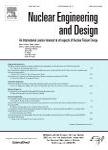版权所有:内蒙古大学图书馆 技术提供:维普资讯• 智图
内蒙古自治区呼和浩特市赛罕区大学西街235号 邮编: 010021

作者机构:11 Hamilton Rd Setauket NY 11733 USA
出 版 物:《NUCLEAR ENGINEERING AND DESIGN》 (核工程与设计)
年 卷 期:2011年第241卷第10期
页 面:4237-4260页
核心收录:
学科分类:08[工学] 0827[工学-核科学与技术]
主 题:TWO-phase flow CODING theory FIELD theory (Physics) NUCLEAR reactors -- Safety measures HYDRAULICS NUCLEAR power plants HEAT transfer
摘 要:The field equations for two-phase flow in the computer code TRAC/RELAP Advanced Computational Engine or TRACE are examined to determine their validity, their capabilities and limitations in resolving nuclear reactor safety issues. TRACE was developed for the NRC to predict thermohydraulic phenomena in nuclear power plants during operational transients and postulated accidents. TRACE is based on the rigorously derived and well-established two-fluid field equations for 1-D and 3-D two-phase flow. It is shown that: (1) The two-fluid field equations for mass conservation as implemented in TRACE are wrong because local mass balances in TRACE are in conflict with mass conservation for the whole reactor system, as shown in Section 3.1. (2) Wrong equations of motion are used in TRACE in place of momentum balances, compromising at branch points the prediction of momentum transfer between, and the coupling of, loops in hydraulic networks by impedance (form loss and wall shear) and by inertia and thereby the simulation of reactor component interactions. (3) Most seriously, TRACE calculation of heat transfer from fuel elements is incorrect for single and two-phase flows, because Eq. (3-4) of the TRACE Manual is wrong (see Section 5.2). (4) Boundary conditions for momentum and energy balances in TRACE are restricted to flow regimes(1) with single-phase wall contact because TRACE lacks constitutive relations for solid-fluid exchange of momentum and heat in prevailing flow regimes. Without a quantified assessment of consequences from (3) to (4), predictions of phasic fluid velocities, fuel temperatures and important safety parameters, e.g., peak clad temperature, are questionable. Moreover, TRACE cannot predict 3-D single- or two-phase flows because: (5) incorrectly averaged equations are used for 3-D predictions, (6) fluid shear is ignored but needed to predict counter-current flows with the two-fluid model, and (7) fictitious body forces and fictitious distributed mass and heat